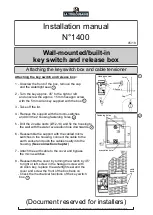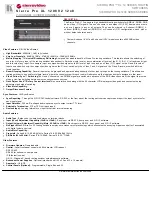
Chapter 4
| Interface Configuration
Port Configuration
– 119 –
Showing Port or Trunk
Statistics
Use the Interface > Port/Trunk > Statistics or Chart page to display standard
statistics on network traffic from the Interfaces Group and Ethernet-like MIBs, as
well as a detailed breakdown of traffic based on the RMON MIB. Interfaces and
Ethernet-like statistics display errors on the traffic passing through each port. This
information can be used to identify potential problems with the switch (such as a
faulty port or unusually heavy loading). RMON statistics provide access to a broad
range of statistics, including a total count of different frame types and sizes passing
through each port. All values displayed have been accumulated since the last
system reboot, and are shown as counts per second. Statistics are refreshed every
60 seconds by default.
Note:
RMON groups 2, 3 and 9 can only be accessed using SNMP management
software.
Parameters
These parameters are displayed:
Table 6: Port Statistics
Parameter
Description
Interface Statistics
Received Octets
The total number of octets received on the interface, including framing
characters.
Transmitted Octets
The total number of octets transmitted out of the interface, including
framing characters.
Received Errors
The number of inbound packets that contained errors preventing them
from being deliverable to a higher-layer protocol.
Transmitted Errors
The number of outbound packets that could not be transmitted
because of errors.
Received Unicast Packets
The number of subnetwork-unicast packets delivered to a higher-layer
protocol.
Transmitted Unicast
Packets
The total number of packets that higher-level protocols requested be
transmitted to a subnetwork-unicast address, including those that
were discarded or not sent.
Received Discarded Packets The number of inbound packets which were chosen to be discarded
even though no errors had been detected to prevent their being
deliverable to a higher-layer protocol. One possible reason for
discarding such a packet could be to free up buffer space.
Transmitted Discarded
Packets
The number of outbound packets which were chosen to be discarded
even though no errors had been detected to prevent their being
transmitted. One possible reason for discarding such a packet could be
to free up buffer space.
Received Multicast Packets
The number of packets, delivered by this sub-layer to a higher (sub-
)layer, which were addressed to a multicast address at this sub-layer.
Transmitted Multicast
Packets
The total number of packets that higher-level protocols requested be
transmitted, and which were addressed to a multicast address at this
sub-layer, including those that were discarded or not sent.
Received Broadcast Packets The number of packets, delivered by this sub-layer to a higher (sub-
)layer, which were addressed to a broadcast address at this sub-layer.
Summary of Contents for GTL-2881
Page 34: ...Section I Getting Started 34 ...
Page 48: ...Section II Web Configuration 48 Unicast Routing on page 651 ...
Page 151: ...Chapter 4 Interface Configuration VLAN Trunking 151 Figure 69 Configuring VLAN Trunking ...
Page 152: ...Chapter 4 Interface Configuration VLAN Trunking 152 ...
Page 230: ...Chapter 8 Congestion Control Automatic Traffic Control 230 ...
Page 596: ...Chapter 14 Multicast Filtering Multicast VLAN Registration for IPv6 596 ...
Page 620: ...Chapter 15 IP Configuration Setting the Switch s IP Address IP Version 6 620 ...
Page 672: ...Section III Appendices 672 ...
Page 678: ...Appendix A Software Specifications Management Information Bases 678 ...
Page 688: ...Appendix C License Statement GPL Code Statement Notification of Compliance 688 ...
Page 696: ...Glossary 696 ...
Page 706: ...GTL 2881 GTL 2882 E112016 ST R01 ...
















































